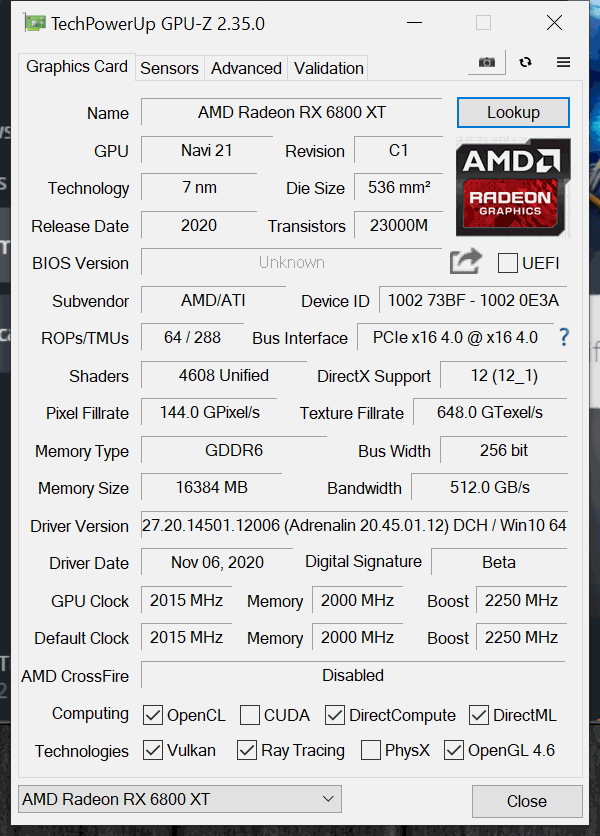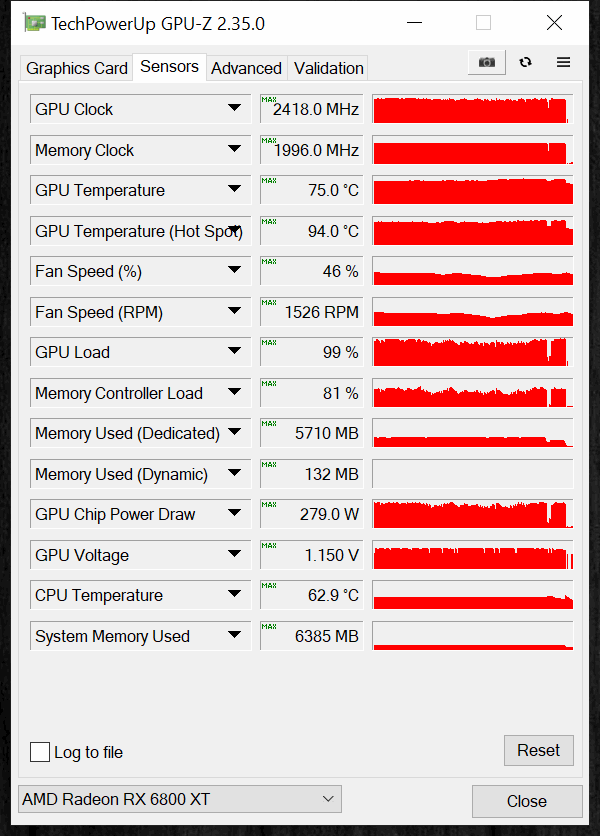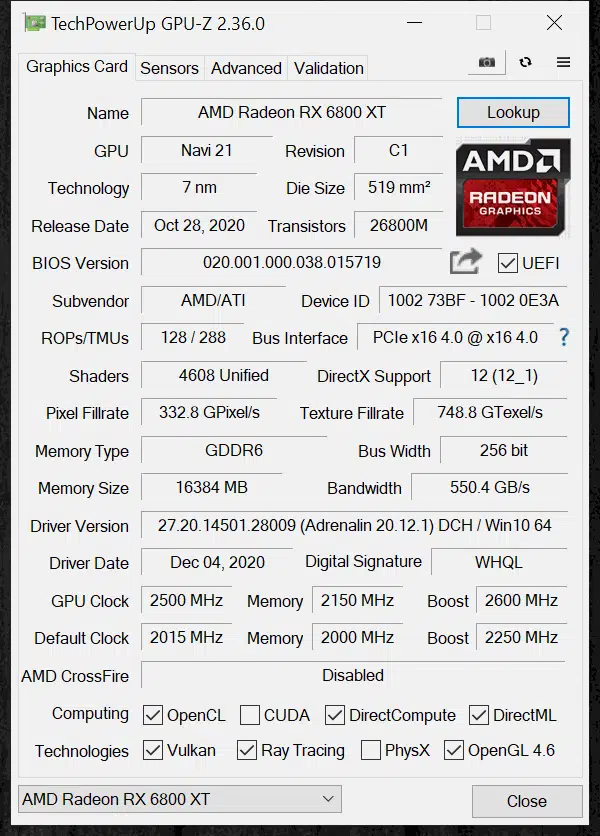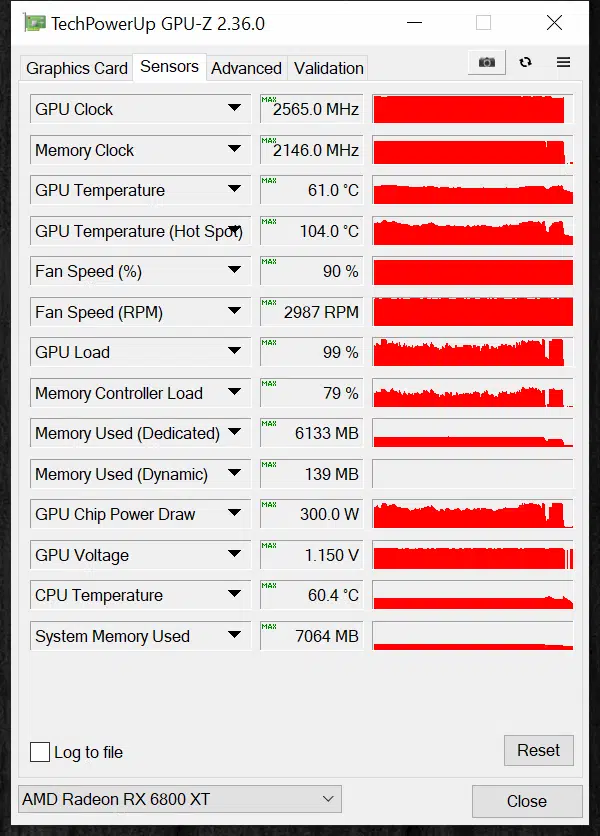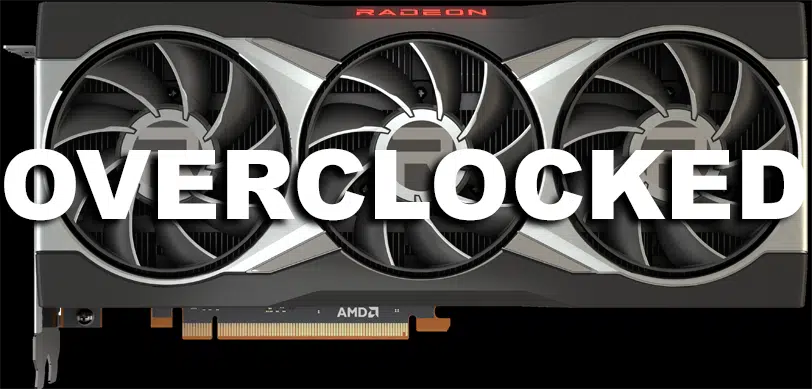
Introduction
AMD launched the Radeon RX 6000 series of video cards on November 18th, 2020, also known as Big Navi. At the very high-end is the $999 Radeon RX 6900 XT. Right below that is the $649 Radeon RX 6800 XT and then below that is the $579 Radeon RX 6800. The video card that compares to NVIDIA’s most recent video card launch, is the Radeon RX 6800 XT at $649. It competes directly with NVIDIA’s GeForce RTX 3080. At only $50 apart, with the advantage in price going to the Radeon RX 6800 XT, squeezing every bit of performance out of the video card is important.
We aren’t going to go into detail on either video card today, we’ve done that in each launch review for both video cards. You can read our launch review on the Radeon RX 6800 XT as well as the GeForce RTX 3080. Today we are interested in finding out how high we can overclock the Radeon RX 6800 XT, and how much performance benefit we get from that. We will then compare that performance to the GeForce RTX 3080 Founders Edition to see how they compare. If you wish to see how well the GeForce RTX 3080 Founders Edition overclocked, we have a separate review on that as well.
Before we dive in though, let’s do a quick brief on the specifications and clock speeds the Radeon RX 6800 XT runs at. The $649 Radeon RX 6800 XT is based on AMD’s new RDNA2 architecture and manufactured on TSMC 7nm. It has 72 Compute Units, 72 Ray Accelerators, 4,608 Stream Processors, 128 ROPs, and 128MB of AMD Infinity Cache. The Game GPU Clock is set at 2015MHz and the Boost GPU Clock (up to) is 2250MHz. It has 16GB of GDDR6 at 16GHz on a 256-bit memory bus providing 512GB/s of memory bandwidth. The Board Power is rated at 300W.
How to Overclock the Radeon RX 6800 XT
How do you overclock the AMD Radeon RX 6800 XT video card? Before we find out how high it can overclock, we first need to find out what it runs at by default. AMD has two different clock domains. There is the Game Clock and the “Max” Boost Clock that the GPU is capable of boosting to in certain workloads. For the most part, the Game Clock of 2015MHz is what you should expect while gaming.
However, because of the dynamic nature of the GPU frequency, it can clock up to 2250MHz while gaming. Basically, the clock speed will be anywhere between 2015-2250MHz while gaming. It will jump all over the place based on many sensor inputs about thermals, temp, power, voltage, and even the level of workload and types of workload that is stressing different parts of the GPU.
In our review of the Radeon RX 6800 XT, we actually looked at what the real-world GPU frequency is while gaming. You can see in the graph on this page how that turned out. The GPU frequency did jump all over the place, but it ended up being much higher than we thought. It actually remained well above the 2015MHz clock domain at all times. In fact, it was even in excess of the 2250MHz clock domain! It started very high at 2300MHz and then dropped down after a minute to mostly around that or upwards of that 2250MHz mark. The average clock speed turned out to be 2265MHz.
Therefore, that is our starting baseline for overclocking. You can also see in GPUz that at default Voltage was at 1.150V, GPU Temp was 75c at 46% fan speed on automatic and GPU Chip Power Draw was 279W. That’s the default operation we are comparing the overclock with.
Highest Overclock on Radeon RX 6800 XT
Overclocking the AMD Radeon RX 6800 XT is limited at the moment in what software programs support overclocking. At this time, MSI Afterburner will not work. We have to rely on the features available in the AMD Radeon Software itself for overclocking. Thankfully, these days that support and features are very comprehensive. It allows customizing power target, fan speed, GPU frequency, and memory frequency and timings. It does not, however, allow us to raise the Voltage at the moment on the Radeon RX 6800 XT GPU. Our maximum overclock is shown in the screenshot below.

The first thing to note from the AMD Performance Tuning is that we were able to manually overclock. We were able to increase the Power Tuning up 15%. This is essential, and the most we could raise it. Second, we were able to turn on advanced control for the fan speed and raise it to 100% at all times and also turn off Zero RPM fan feature. We set the fan at 100% to ensure the highest overclock.
GPU Frequency
Next up is the GPU frequency, this is where it gets a little complex. There are two options, a Min Frequency and a Max Frequency. Just raising the Max Frequency will not result in an overclock, or a very high one. You need to actually raise the Min Frequency, but you don’t want to set them to the same value, that will be unstable. We found keeping them about 200MHz apart worked best for us. There isn’t really a science here, it is all trial and error. In our trial and error, which took a lot of time to finesse, we found the highest overclock for our card was 2400MHz on the Min Frequency and 2600MHz on the Max Frequency. This resulted in positive performance increases in every game, at 4K and with Ray Tracing.
We tried to set it a bit higher to 2500MHz Min Frequency and 2700MHz Max Frequency, and while this setting actually worked, it actually lowered game performance at 4K and with Ray Tracing. So, when we backed it down to 2400MHz-2600MHz then we saw the most positive performance increases. We’ll see what this turns out in real-world frequency below. As for the GPU Voltage, we were not able to increase it at all, it was locked at a maximum of 1150mV.
Memory
On the memory side of things, Performance Tuning only lets us set the memory up to a maximum of 2150MHz. The default speed is 2000MHz. The slider simply would not go any higher, so the memory is locked at a maximum of 2150MHz. This results in a maximum memory frequency of 17.2GHz versus the default of 16GHz. That boosts the memory bandwidth up to 550GB/s up from the default of 512GB/s. We think the memory might be capable of more, but it’s simply software locked.
Overclock Comparison Graph

Here is the graph that shows how the overclock compares to the default frequency. The orange line is the overclock, blue is the default. At default, it’s all over the place, and our overclock definitely stabilizes the frequency and makes it more consistent. The overclock stays between 2400MHz-2530MHz. It maxes out at 2550MHz briefly. The average default frequency in this new run is 2257MHz. The average of the overclock frequency is now 2504MHz. That’s an 11% overclock on the GPU frequency. Then with the memory, the memory is a smaller 8% memory overclock.

